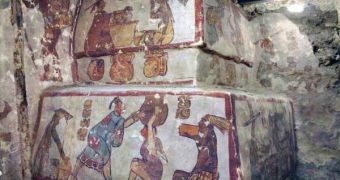The everyday life of ancient Mayans has been a subject of speculation for many generations, mostly because there are very little records of this aspect of the old society. Most depictions that have endured up to this day are of official matters, and do not represent the actions and behaviors of the common folk. A new series of recently discovered murals now provide archaeologists and historians with a wealth of information on the life of an average Mayan citizen, LiveScience reports.
The murals, which are described in detail in the November 9 issue of the respected journal Proceedings of the National Academy of Sciences (PNAS), were found at the famous Maya site near Calakmul, Mexico, a short distance away from the border with Guatemala. The investigators were digging up a pyramid mound structure when they came across the beautifully preserved structures. University of Pennsylvania Museum scientist Simon Martin, who studied the hieroglyphs and symbols on the murals, says that the discovery was a complete shock, except of the good kind.
The expert adds that, in over a century of studying the Maya, no researcher has ever come by this type of discovery before. Like those of all other ancient civilizations, most records that remained from the Maya are of the ruling classes, the priests, military and artisans, and not of the lower folks. The last category was however the dominant part of the population in this civilization and in others as well. Therefore, knowing how they behaved and what their daily actions were may be more representative for learning about the culture than studying many other “official” accounts.
“We almost never get a view of what other layers of society are doing or what they look like, so this is one of the things that makes [the murals] so special,” Martin explains. He adds that the murals were discovered under a layer of clay, which suggests that someone went through the trouble of preserving these drawings for many years. This “might suggest that it was something pretty special,” he states. The murals themselves reveal common scenes, such as people preparing food or smoking tobacco leaves.
“Tremendous amounts of Maya culture and writing have just perished. It's not like Egypt, where even bits of paper in the sand can survive 5,000 years; this is an extremely hostile environment, it's extremely humid,” Martin says of the find. Additionally, he ventures, there are very little chances that other, similar murals endured over the ages. Most likely, priceless depictions of Mayan life disappeared from tombs and pyramids with the passing of the millennia.

 14 DAY TRIAL //
14 DAY TRIAL //